Himachal Travel Guide
1. Hadimba Devi Temple, Manali:
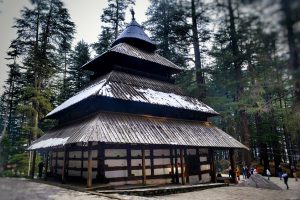
Hadimba Devi Temple is located in Manali. It is also known as Dhungari Temple and properly known as Hadimba Devi Temple. It was built in 1553 AD by Maharaja Bahadur Singh. The temple has been built in pagoda style of 4 tiered roofs, dedicated to Hidimba Devi, who is wife of Bhima. In Mahabharata, there is a story about Hidimba, the demon ruler of mountains and brother of Hidimbi. It is told that Pandava spent a part of their 14 years exile in Himachal Pradesh, where Bhima, one of the five brothers, killed Hidimba and married his sister. When Bhima decided to leave the town, Hidmbi refused to come with him and chose to stay back, meditate and pray to the gods rather. Impressed by her dedication, the gods relented themselves and bestowed her with the status of a goddess, an incarnation of Shakti.
2. Manu Temple, Manali:
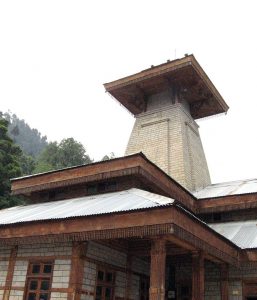
The Manu Temple is located in old Manali, at a distance of three kilometres from the main market, surrounded by lush green forests, Situated on the banks of river Beas. Manu Temple is dedicated to the Manu who wrote Manu smriti – the Indian Sage, who was acknowledged to be the creator of this world. In fact, some legends rely heavily on the fact that the present-day temple is the exact place where sage Manu would meditate regularly. The temple has great historic and religious significance. Numerous intricate scriptures can be seen on the temple pillars and walls. It also offers splendid views of the valley and town, which is very beautiful and peaceful.
3. Vashisht Village, Manali:
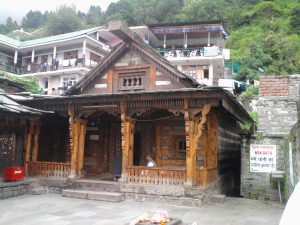
Vashisht Village is beautiful small village located east of the Beas River spread the energy of positivity and is a true backpacker’s paradise at a distance of 6 km from Manali. It is popular for Natural springs and sandstone temples. Vashist village is extremely significant when it comes to the heritage Indian Hindu culture as one of the Saptrishis saint Vashistha stayed there for sometimes. There is a hot water spring known as Vashisht Kund. According to legend the saddened Rishi Vashisht after knowing that his children were killed by Vishwamitra tried to commit suicide, but the river refused to kill him. The river was therefore named as Vipasha which means freedom from bondage. It was later shortened to Beas River. He began mediating and vowed to start his new life. The Vashisht temple is believed to be more than 4000 years old. A temple, which enshrines a black stone figure of a ‘Rishi’ or sage wearing a lion cloth, is located in proximity to the springs. Pilgrimage sites dedicated to Kala Guru and the 7th incarnation of Hindu deity Vishnu, Rama, are also located in the Vashisht Village. The springs of Vashisht are believed to possess medicinal properties. The waters of the hot brooks are believed to heal skin diseases. Separate bathing provisions for men and women have been arranged at the spring by the government.
4. Van Vihar, Manali:
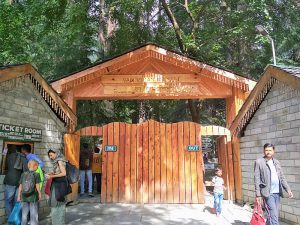
Van Vihar National Park is Located favourably on the Mall Road, one of the most frequented attractions in Manali. It is famous for its Deodar trees provide shade to the whole area and a manmade lake, built right in the middle of the forest. This park is populated with many deodar trees that for the convenience of visitors, the park is provided with concrete as well as wooden benches. From children to grandparents, Van Vihar holds a unique charm for everyone. It is perfect destination for couples trying to find some solace in middle of a crowd. The nature adds to the romance! Also, the sunsets here are quite popular among the localities. With the sun drowning in the backdrop, the lake and the trees take up a whole new mystical look that is hard to forget in this lifetime.
5. Tibetan Monastery Temple, Manali:
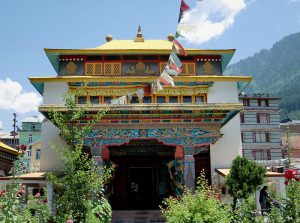
Tibetan Monastery is one of the oldest and famous place in Manali. Due to huge number of tibetan peoples settled in Kullu Manali Tibetan Monasteries has been set up. The main attraction of the monastery is the handicrafts of Tibetan artistry and the carpets that are woven and sold in the monastery. The Gadhan Thekchoking Gompa in Manali was constructed in the year 1969. The architecture of the monastery represents the Tibetan style.
6. Solang Valley, Solang:
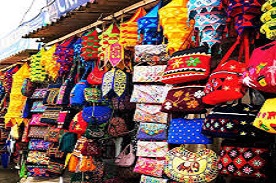
Solang Valley is one of the most popular tourist destinations in Himachal Pradesh, situated on the way to Rohtang from Manali, located in 14 kilometres to the north west of the main town of Manali. It is located between the Solang village and Beas Kund and offers majestic views of glaciers and snow-capped mountain. It is also known as the ‘Snow Valley,’ which is famous for hosting various winter adventure sports like skiing, parachuting, paragliding, trekking, and mountaineering. The Mountaineering Institute of Manali has installed a ski lift for training purpose and there is a small hut and a guest house that belongs to the Mountaineering and Allied Sports Institute. Every Year, the winter skiing festival is also organized in Solang and the activities like Zorbing, Horse riding & Snow Motor Bikes riding are offered for the entertainment of tourists.
7. Rohtang Pass:

Rohtang Pass is located at a distance of 51 kilometres from Manali, can be reached only by road. The pass is located at a massive height of 3978 metres on Manali- Keylong road. It offers wonderful views of surrounding peaks, glaciers, Chandra River, and Lahaul Valley, along with twin peaks of Geypan. Self-drive on this road is quite challenging due to its meandering curves and thin stretch. Other options are local cab or tourist bus. Tourists can enjoy various kinds of adventure activities at Snow Point such as sledge ride, mountain biking, snow scooter, ski ride, tyre drop and skiing. Equipment are available on rent. Enjoy making igloos with snow. There are no accommodation options here. Rohtang Pass is open between June and October as during the remaining months, it is covered with a snow, making it inaccessible
8. Kullu:

Pipli village is known for designing beautiful Applique handicrafts, located at 36 kilometers from Puri and 18 kilometers from Bhubaneswar. Variety of handicrafts is made here in six styles -‘Bakhia’, ‘Taropa’, ‘Ganthi’, ‘Chikana’, Button Hole and ‘Ruching’ by artisans such as puppets, handbags, wall hangings, purses, cushion covers, bedspreads, lampshades, pillow covers, table cloths, lanterns, etc. The craft, locally called Chandua, is used to adorn the chariots of Lord Jagannath and his siblings during the annual Ratha Yatra.
9. Naggar Castle:

Naggar Castle is a medieval castle, located in 22 kilometres north at Kullu and 230 kilometres from Shimla. It is Built by Raja Sidh Singh of Kullu in around 1460 A.D. Naggar Castle is built in the traditional pahari style (Kathkuni); the castle has a central courtyard and there are exquisite wood carvings and arched balconies with serene views of the Beas Valley. The shock-bearing unique method of construction had this structure withstanding the earthquake of 1905, when most of the region was devastated. The traditional local architecture comprises of walls composed of alternate layers of wooden beams and proportionate stone. Essentially, the whole building including doors and windows has been fixed without the use of any metal including iron. , there is also a museum that showcases exquisite arts and crafts of Himachal Pradesh. The exhibits include shawls, carpets, local products, masks and statues of deities in traditional Himachali costume. The castle compound also houses the Jagatipatt Temple.
10. Kalibari Temple, Shimla:

Kali Bari Temple is situated on Bantony Hill, Shimla, dedicated to fearsome reincarnation of Goddess Kali. Kali Bari temple was originally built in 1845 by a Bengali Brahmin Ram Charan Brahamchari in the vicinity of Rothney Castle on Jakhoo Hill. The shrine houses a captivating idol of Goddess Kali beautifully adorned with jewellery and colourful flowers. Locals believe that Goddess Kali lived on Jakhoo Hill which was the location of an ancient temple that was later relocated to Kali Bari by the British. Locals also know Goddess Kali as Goddess Shyamala. The name of the city, Shimla, was derived from the Goddesses’ name. A large number of devotees visit the Kali Bari Temple seeking Goddess Kali’s blessings and to offer her prayers during the festival of Navratri.
11. Shimla State Museum, Shimla

State Museum is located 2.5 km west of the Scandal Point on the Inverarm Hill. The history of the building, it was the private residence of Lord William Beresford. He was the Military Secretary to the then Viceroy of India, Lord William Bentinck. When he left India, the mansion was inhabited by Sir Edwin Collan and thereafter by Sir Edward Law. After independence, it served as the residence of Indian Government officials. It was transformed into a museum on January 26, 1974 with the sole aim of collecting and preserving the historical, artistic and archaeological items of the Himachal Pradesh State.The museum boasts of having a grand collection of ancient historical sculptures, coins, paintings and photographs collected from all over the state and the country. It also houses a library which has around 10,000 books, journals and magazines. Sculpture gallery has metal, wooden and stone sculptures. In the painting section, Pahari and Rajasthani Miniature Painting, religious paintings, contemporary paintings and Mughal paintings have been put on display. Other than these rare artifacts, the museum also has a unique collection of Himachali dolls. Art and history lovers must visit the museum while touring Shimla.
12. Sankat Mochan, Shimla

Sankat Mochan temple is situated at Taradevi on the Kalka- Shimla National Highway 22, at a distance of 5.5 km from Shimla Railway Station and 6.4 km from Shimla Old Bus Stand. Temple is dedicated to Lord Hanuman. This is a perfect place for meditation as it offers a calm and peaceful atmosphere to the devotees visiting this temple. The background of the temple consists of the imposing and lofty Himalayan ranges. The history about this temple was that Baba Neeb Karori Ji Maharaj came to this beautiful place in 1950 and discovered the perfect spot for meditation. After staying here for 10 days, he desired that a temple dedicated to Lord Hanuman should be built here. Baba’s faithful devotees included the governor of Himachal Pradesh, who along with Bhagvan Sahai took up the task of building the temple and fulfilling their Guru’s wish.The temple was consecrated on the 21st of June 1966. The most important festivals celebrated at the Sankat Mochan temple are Ramnavmi, Hanuman Jayanti and Dusshera
13. Jakhu Hills:

Jakhu Hills is the highest peak of Shimla. Jakhu Hill is known for the Jakhu Temple, dedicated to Lord Hanuman. According to the Ramayana, Hanuman stopped at the location to rest while searching for the Sanjivni Booti to revive Lakshmana. A giant 108-feet-high idol of Hanuman was unveiled at Jakhoo Hanuman temple on 4 November 2010.The temple is accessible by foot, horse, taxi or ropeway. The Jakhu Ropeway is an aerial lift that links a point near the centre of Shimla to the temple. It was developed by Jagson International Limited and opened in 2017
14. Summer Hills:

Summer Hills is located 5 km from Shimla. It is also known as the Potter hill. Summer Hill is a picturesque spot on Shimla-Kalka railway line that offers amazing views of the snow covered mountains. Tourists can see the amazing views of the Sunrise and the Sunset. The Manorville Haveli and the ‘Himachal Pradesh University’ are located on this hill with the spectacular background view of the enchanting hill. This place is full of pine and deodar trees, nature lovers enjoy the great sight.Tourists can indulge in a lot of adventure activities such as trekking and walking around the area. You can also ride a horse passing the thick jungles.
15. Manikaran:

Manikaran is located in the Parvati Valley on river Parvati. It is a pilgrimage centre for Hindus and Sikhs. The Hindus believe that Manu recreated human life in Manikaran after the flood, making it a sacred area. It has many temples and a gurudwara. There are temples of the Hindu deities Rama, Krishna, and Vishnu. The area is well known for its hot springs and its beautiful landscape. A pilgrimage to this place is thought of as complete. It is also believed that there is no need to pay a visit to Kashi after visiting this place. The water of the spring is also supposed to have curative powers. The water is so hot that rice can be cooked in it.


